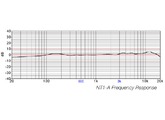« Gritty Delicate Natural »
Published on 09/13/14 at 18:43The Rode NT1-A is a large diaphragm cardioid condenser microphone. It runs on phantom power, so make sure your interface or mixer/preamp provides phantom power. When it comes to setting up, it’s a breeze. Just make sure you mute the channel when you plug in so you don’t damage the mic. Mute before disconnecting when you’re done for the same reason.
Rode itself as a brand is highly respected in the music industry for making quality products that don’t break the bank, and the NT1-A (along with the NT1) has a reputation as being one of the quietest microphones in the market.
I picked mine up second hand on Ebay and collected it from the seller, who worked at MTV in London, and had been using it for voice over work. I used it mostly for acoustic guitar and vocal.
The mic came in a sturdy metal case, complete with a shock mount and a dust cover.
OVERALL OPINION
The quality of the mic itself, for the money is excellent. It has a very natural sound, but also a gritty character that I find works with acoustic guitars and vocals.
It’s hard to explain the sound - it’s a sort of brittle tone - and I think with microphones it’s always a very subjective thing that varies from voice to voice and from mic to mic. But for me, I found the microphone was always a pleasure to use.
Being a very quiet microphone, I found the mic useable in bedroom recording situations (obviously I still had to eliminate all background noise as much as possible).
The frequency response is 20-20,000Hz. Output impedance of 100 ohms. Self noise only 5dB
Placing the microphone perhaps 6 inches or so from the sound source creates a nice ambient sound. Up close you get a much stronger sound. I find a combination of up close and ambient can create good results (obviously this requires either 2 mics or 2 takes), but this depends on what you’re doing.
My favorite way of using the microphone (as a singer songwriter) was to place the mic so as to form a triangle between my guitar’s sound hole, my mouth, and the mic. This uses the ‘rules of thirds’ principle of recording - creating a very honest recreation of my performance. The slight grittiness and brittleness of the sound works very well with acoustic music. The problem is that when you come to mixing it’s very hard to tune vocals so for someone like me (who’s not a great singer) I always had to go back to recording the guitar and voice separately. But for getting demos down it was awesome.
All Rode products come with a 10 year warranty so as long as you take care of your microphone you can be assured it will serve you well.
Rode itself as a brand is highly respected in the music industry for making quality products that don’t break the bank, and the NT1-A (along with the NT1) has a reputation as being one of the quietest microphones in the market.
I picked mine up second hand on Ebay and collected it from the seller, who worked at MTV in London, and had been using it for voice over work. I used it mostly for acoustic guitar and vocal.
The mic came in a sturdy metal case, complete with a shock mount and a dust cover.
OVERALL OPINION
The quality of the mic itself, for the money is excellent. It has a very natural sound, but also a gritty character that I find works with acoustic guitars and vocals.
It’s hard to explain the sound - it’s a sort of brittle tone - and I think with microphones it’s always a very subjective thing that varies from voice to voice and from mic to mic. But for me, I found the microphone was always a pleasure to use.
Being a very quiet microphone, I found the mic useable in bedroom recording situations (obviously I still had to eliminate all background noise as much as possible).
The frequency response is 20-20,000Hz. Output impedance of 100 ohms. Self noise only 5dB
Placing the microphone perhaps 6 inches or so from the sound source creates a nice ambient sound. Up close you get a much stronger sound. I find a combination of up close and ambient can create good results (obviously this requires either 2 mics or 2 takes), but this depends on what you’re doing.
My favorite way of using the microphone (as a singer songwriter) was to place the mic so as to form a triangle between my guitar’s sound hole, my mouth, and the mic. This uses the ‘rules of thirds’ principle of recording - creating a very honest recreation of my performance. The slight grittiness and brittleness of the sound works very well with acoustic music. The problem is that when you come to mixing it’s very hard to tune vocals so for someone like me (who’s not a great singer) I always had to go back to recording the guitar and voice separately. But for getting demos down it was awesome.
All Rode products come with a 10 year warranty so as long as you take care of your microphone you can be assured it will serve you well.

